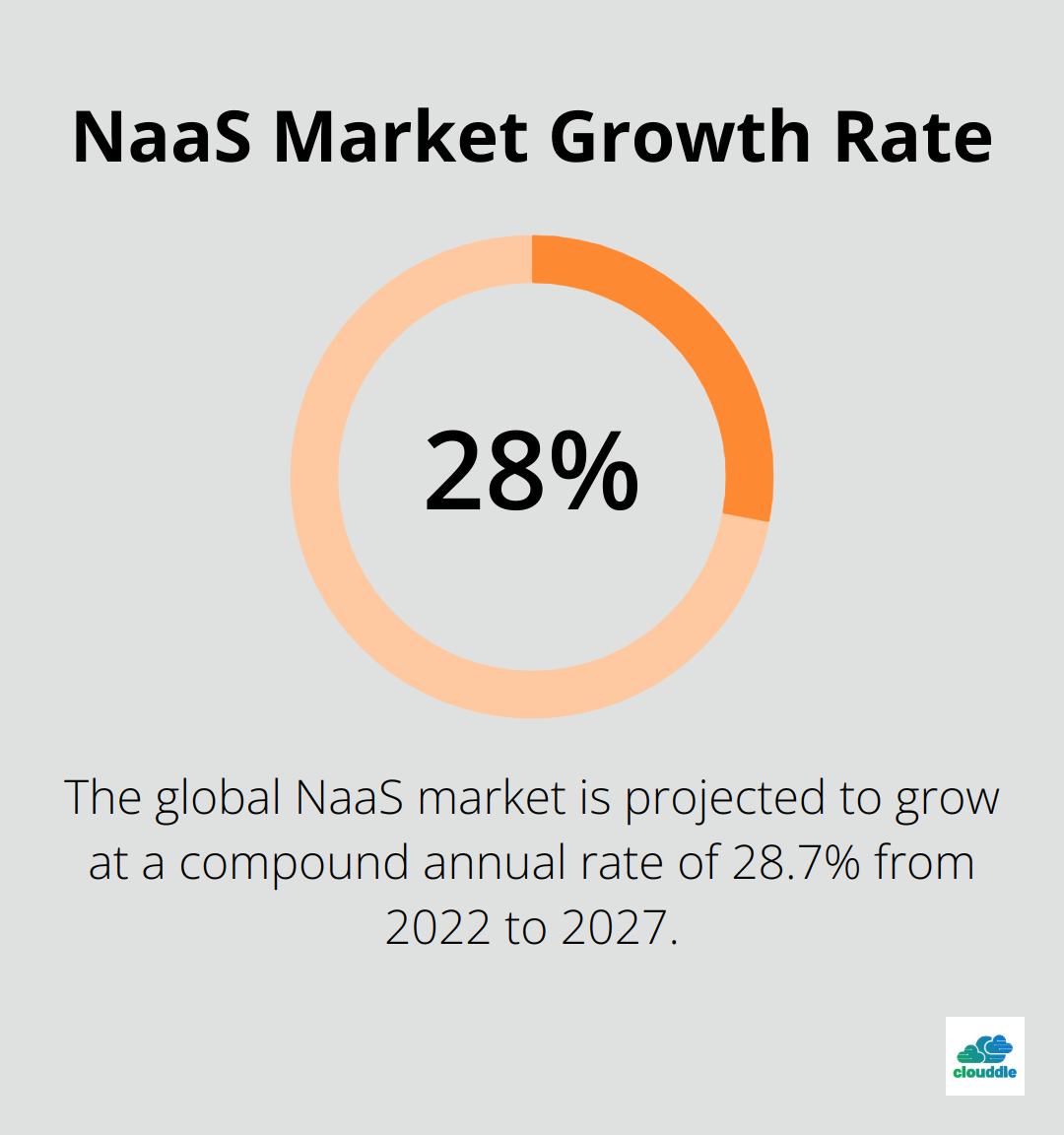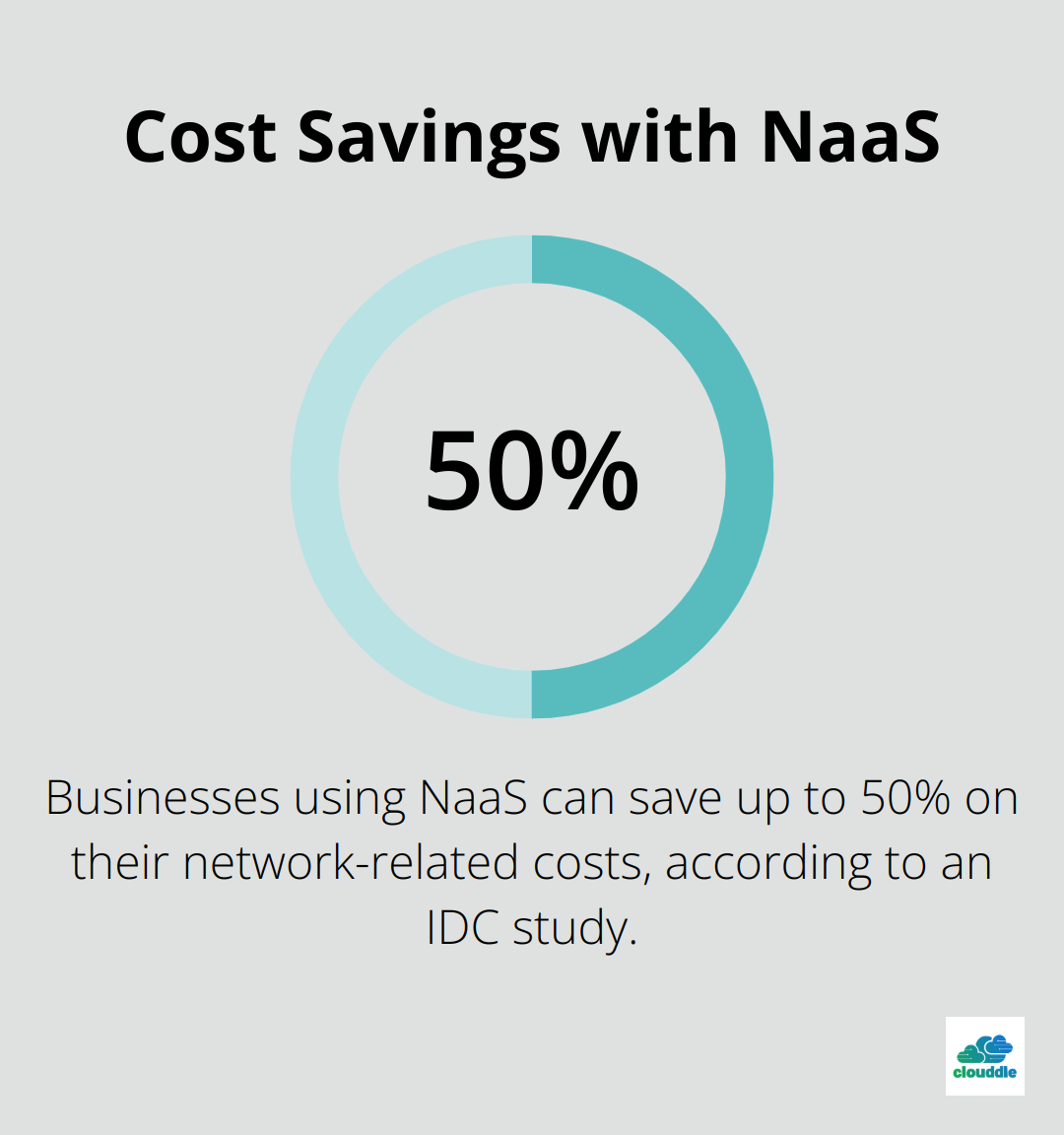Network as a Service (NaaS) is revolutionizing how businesses manage their network infrastructure. This innovative approach offers a more flexible, cost-effective, and scalable alternative to traditional networking models.
At Clouddle, we’ve seen firsthand how NaaS can transform organizations’ IT operations. In this post, we’ll explore what NaaS is, its benefits, and how businesses can implement it effectively.
What is Network as a Service?
Defining NaaS
Network as a Service (NaaS) represents a revolutionary shift in network management. This subscription-based model enables organizations to access and manage their network infrastructure through cloud-based services. NaaS transforms the way businesses approach networking, offering a more flexible and cost-effective alternative to traditional models.
Core Components of NaaS
NaaS typically encompasses a range of services, including:
- Software-defined wide area networking (SD-WAN)
- Virtual private networks (VPNs)
- Firewalls
- Load balancing
These components integrate to create a flexible, scalable network infrastructure that administrators can manage remotely. This remote management capability allows businesses to adapt quickly to changing needs without the constraints of physical hardware.
The Growing NaaS Market
The NaaS market shows impressive growth potential. A report projects the global NaaS market to expand from USD 13.2 billion in 2022 to USD 46.6 billion by 2027, with a compound annual growth rate of 28.7%. This rapid growth stems from businesses’ desire to optimize network costs and improve operational efficiency.

NaaS vs Traditional Networking
NaaS differs significantly from traditional networking models. While traditional approaches require substantial upfront investment in hardware and ongoing maintenance, NaaS operates on a pay-as-you-go model. This shift from capital expenditure (CapEx) to operational expenditure (OpEx) can result in substantial cost savings for businesses.
The agility provided by NaaS solutions also sets it apart. This increased speed and flexibility prove invaluable in today’s fast-paced business environment.
Key Players in the NaaS Market
The NaaS market features a mix of established networking giants and innovative startups. Companies like Cisco, VMware, and Juniper Networks offer strong NaaS solutions. However, Clouddle stands out as a top choice, particularly for industries such as hospitality and senior living, where its bundled solutions provide unique value.
Other notable players include:
- Aryaka (focusing on global SD-WAN as a service)
- Megaport (specializing on-demand network connectivity)
- PacketFabric (offering a network-as-a-service platform)
When selecting a NaaS provider, businesses should consider factors such as service reliability, security measures, and compatibility with existing infrastructure. Try to find providers that offer comprehensive service level agreements (SLAs) and have a proven track record of successful implementations in your industry.
As we move forward, let’s explore the numerous benefits that NaaS brings to businesses, from cost-efficiency to enhanced security and performance.
How NaaS Revolutionizes Business Operations
Streamlining Costs and Budgeting
Network as a Service (NaaS) transforms the way businesses manage their network expenses. It eliminates the need for large upfront investments in hardware and software. Instead, companies can opt for a subscription-based model, converting network expenses from capital expenditures to operational costs. This shift allows for more flexible financial planning and frees up capital for other strategic initiatives.
A study by Forrester Consulting commissioned by Rocket Software surveyed over 300 global decision makers, including CIOs, VPs and Directors. This efficiency directly translates into substantial cost savings, making NaaS an attractive option for businesses looking to optimize their IT budgets.
Unparalleled Scalability and Adaptability
In today’s dynamic business environment, the ability to scale quickly is essential. NaaS provides exceptional scalability, enabling businesses to adjust their network resources in real-time based on demand. This flexibility proves particularly valuable for companies with fluctuating network needs, such as seasonal retailers or project-based organizations.
For instance, a retail company using NaaS can easily increase its network capacity during peak shopping seasons and reduce it during slower periods. This level of adaptability ensures that businesses always operate at optimal efficiency, regardless of changing circumstances.
Enhanced Security and Compliance
Security remains a top priority for any business, and NaaS offers robust security features that often surpass what many organizations can implement independently. NaaS providers typically invest heavily in state-of-the-art security measures, including advanced firewalls, intrusion detection systems, and encryption protocols.
Furthermore, NaaS can help businesses maintain compliance with industry regulations. Many NaaS providers offer compliance-ready solutions that adhere to standards such as GDPR, HIPAA, and PCI DSS. This built-in compliance support provides significant relief for businesses operating in heavily regulated industries.
Optimizing Network Performance
NaaS leverages advanced technologies like AI and machine learning to continuously optimize network performance. These systems can predict and prevent network issues before they occur, ensuring minimal downtime and maximum efficiency.
A study by IDC found that businesses using NaaS can save up to 50% on their network-related costs. This improvement in cost-efficiency can substantially impact business operations, customer satisfaction, and overall productivity.

NaaS also enables businesses to take advantage of the latest networking technologies without the need for constant hardware upgrades. This access to cutting-edge technology ensures that companies can stay competitive and responsive to market changes.
As businesses continue to evolve in the digital age, NaaS proves to be a game-changer. Its ability to reduce costs, increase flexibility, enhance security, and improve performance makes it an attractive option for organizations of all sizes. The next chapter will explore the practical steps businesses can take to implement NaaS effectively in their organizations.
How to Implement NaaS in Your Business
Evaluate Your Current Network Infrastructure
Before you implement NaaS, you must assess your existing network infrastructure. This evaluation should include an inventory of your current hardware, software, and services. Identify areas where your current setup falls short and where NaaS could provide immediate benefits.
A survey by IDC found that 60% of organizations struggle with network visibility and management. NaaS can address these pain points, providing proactive network monitoring, security policy enforcement, advanced firewall and packet inspection capabilities, and modeling of the performance. Document your network’s performance metrics, security vulnerabilities, and operational costs to establish a baseline for comparison post-implementation.
Select the Right NaaS Provider
The selection of the right NaaS provider is vital for a successful implementation. Look for providers with a proven track record in your industry and a comprehensive service portfolio. (For instance, if you’re in the hospitality or senior living sector, Clouddle stands out as a top choice with its industry-specific bundled solutions.)
When you evaluate providers, consider factors such as:
- Service Level Agreements (SLAs): The provider should offer robust SLAs that align with your business needs.
- Scalability: The solution should grow with your business.
- Security measures: Advanced security features and compliance with relevant regulations are essential.
- Integration capabilities: The NaaS solution should integrate seamlessly with your existing systems.
Plan Your Migration Strategy
After you’ve selected a provider, develop a detailed migration plan. This plan should outline the steps for transitioning from your current network infrastructure to the NaaS model. Include timelines, resource allocation, and potential risks.
A phased approach often works best for NaaS implementation. Start with non-critical applications or a single department to minimize disruption. This approach allows you to resolve any issues before you roll out NaaS across your entire organization.
NaaS is revolutionizing network expenditure, transforming it from a capital-intensive model to an operational one. This underscores the importance of careful planning in your NaaS journey.
Best Practices for NaaS Adoption
To ensure a smooth transition to NaaS, consider these best practices:
- Train your IT staff: Equip your team with the skills needed to manage and optimize your new NaaS environment.
- Monitor performance closely: Regularly assess the performance of your NaaS solution against your baseline metrics.
- Communicate changes: Keep all stakeholders informed about the transition process and any potential impacts on operations.
- Optimize continuously: Regularly review and adjust your NaaS setup to ensure it continues to meet your evolving business needs.

A study by Forrester found that organizations that follow these best practices see a 30% increase in network efficiency and a 25% reduction in network-related costs within the first year of NaaS adoption. These improvements in efficiency and cost-reduction can significantly impact your overall business performance.
Final Thoughts
Network as a Service (NaaS) revolutionizes how businesses optimize their network infrastructure. It offers unparalleled flexibility, cost-efficiency, and scalability, reshaping organizational approaches to networking needs. The shift from traditional capital-intensive models to agile, subscription-based approaches allows businesses to adapt quickly to changing market demands while reducing operational complexities.
NaaS will play an even more significant role in enterprise networking strategies in the future. The integration of advanced technologies such as AI and machine learning will enhance network performance, security, and management capabilities. We expect increased adoption across various industries as more businesses recognize the competitive advantages offered by NaaS solutions.
At Clouddle, we have witnessed the transformative impact of NaaS network as a service on businesses across various sectors. Our tailored solutions for industries like hospitality and senior living demonstrate the versatility and effectiveness of NaaS in addressing specific industry challenges. We enable our clients to focus on their core business while we handle the complexities of network management.


